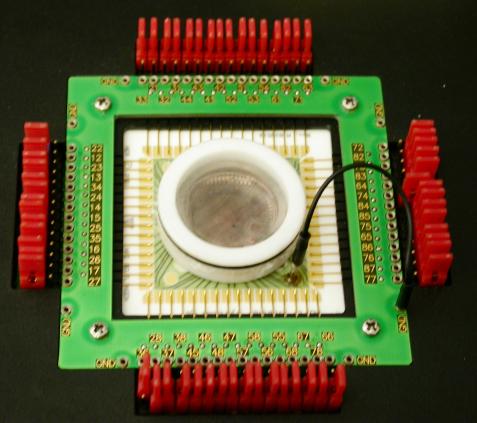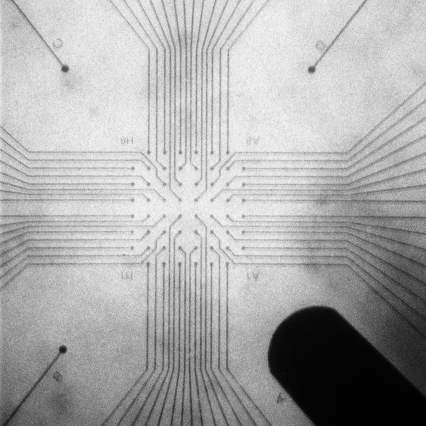Review of prototype of new MEAs from MultiChannel Systems
Review of prototype of new MEAs from MultiChannel Systems
Daniel Wagenaar, February 2003
From: Daniel Wagenaar
To: MEA Users
Subject: Review of prototype of new MEAs from MultiChannel Systems
Date: Feb 13, 2003
Dear MEA users,
I recently had the opportunity to test a new make of multi electrode
arrays from MultiChannel Systems (MCS) [1], and I was impressed with
the recordings I obtained from them, so I'd like to share my
experiences with you. Note that MCS gave me these arrays as a personal
favor because I asked them at Neuroscience whether I could try the new
arrays. MCS did not ask me to write this review.
The new model consists of a smaller glass substrate glued onto a
ceramic carrier. This design made it possible to use considerably
thinner glass than before, which is good news for all those who like
to use short working distances lenses on inverted scopes. Another
advantage of the new carrier is that the pads to which the
pre-amplifier connects with its gold fingers, are much thicker and
softer, which makes for more reliable connections. I didn't even need
to clean the pads of with alcohol before use!
The electrode layout has been improved as well. The basic design is
still an 8x8 grid with the corner pieces missing, but whereas before
one more recording electrode was sacrificied to make space for a
reference (bath ground) electrode, the new design features a reference
electrode located in one corner of the array and accessed through a
separate connector glued on the ceramic carrier (see pictures
below). When inserting the MEA into the pre-amplifier, a separate
short wire is used to connect this to a ground pin on the
pre-amp. While this adds a few seconds of extra fiddling, it does
create a much more reliable connection. Another added feature is a set
of three 100 um diameter electrodes located in the other three corners
of the array, which are accessed through gold pads on the ceramic
carrier. I have not yet attempted to record from those.
The recording array itself consisted of 30 um diameter electrodes with
200 um inter-electrode spacing. RMS noise levels were 3.0 +/- 0.3 uV
in the pre-amplifier's 10 Hz - 5 kHz pass band. I haven't measured the
electrode impedance. When plated with dissociated rat cortical neurons
at 1,000 cells/mm2 [2], most electrodes registered
signals from many cells, with spike-amplitude- to-noise ratios ranging
up to 50. Looking only at amplitude, an average of 1.6 cells could be
isolated per electrode, and many more cells could be recorded
from.
Stimulating through the MEA also worked well: out of 12 electrodes
selected by their level of spontaneous activity, 11 could be used to
elicit activity using biphasic voltage waveforms of less than 1V
amplitude. (Current pulses of 10 uA typically charged up the electrode
to 1V in about 50 us, counting both resistive and capacitive parts of
electrode voltage.)
One of the stated goals of constructing using smaller glass plates is
to get more chips out of a wafer, thus reducing the production cost
per MEA. But even without any cost reduction, the new design is a
great improvement. Be sure to check it out once it becomes generally
available! And if you are planning to attend SIMEA 2003, please visit
us to see some of the science we're using these arrays for [3] [4].
Pictures:

1. Showing the new MEA inserted into a pre-amplifier. Ground wire is
in bottom left. The dish is sealed with one of Steve Potter's patented
Teflon membrane lids [5].

2. Quick snapshot through dissecting scope showing layout of electrodes.
Close-up (archive) photos of electrodes are available at the MCS website.
References:
[1] MultiChannel Systems are at www.multichannelsystems.com.
[2] D A Wagenaar and S M Potter: Real-time multi-channel stimulus
artifact suppression by local curve fitting. J. Neurosci. Meth.
120:2 (2002) 113-120. [pdf]
[3] D A Wagenaar; R Madhavan; S M Potter: Stimulating news for MEA
enthusiasts. Accepted for poster presentation at SIMEA2003, Denton,
Tx, March 5-8 2003.
[4] R Madhavan; D A Wagenaar; C-H Chao; S M Potter: Control of bursting in
dissociated cortical cultures on multi-electrode arrays. Accepted for
poster presentation at SIMEA2003, Denton, Tx, March 5-8 2003.
[5] S M Potter; T B DeMarse: A new approach to neural cell culture for
long-term studies. J. Neurosci. Meth. 110:1-2 (2001) 17-24.
Daniel Wagenaar, California Institute of Technology.
